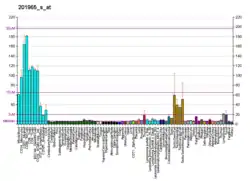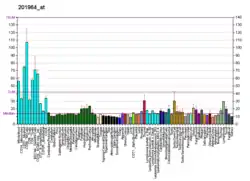SETX
Probable helicase senataxin is an enzyme that in humans is encoded by the SETX gene.[5][6][7]
This gene encodes a protein named senataxin, a 302kDa protein[8]
Sequence and structure
There is high homology between human SETX and yeast Sen1. Sen1 in yeast is a RNA/DNA helicase and the highly conserved sequences between these genes, particularly in the helicase domain, indicates that SETX in humans may have similar roles in gene expression and maintaining genome stability. In Sen1, the N-terminus has shown interactions with the C-terminal domain of RNA polymerase II, ribonuclease III, and NER factor Rad2/XPG. Meanwhile, the C-terminus encodes the DNA/RNA helicase activity.[9] Similarly, SETX encodes the senataxin protein that has a N-terminal that is likely to be involved with interacting with other proteins. Senataxin interacts with RNA polymerase II and poly(A) binding proteins. At the C-terminal, senataxin has a DEAD box helicase domain.[10]
Function
Although senataxin is widely expressed in many tissues in the body, the cellular roles of senataxin are not completely understood. However, based on current research and examining homologs of SETX, senataxin is thought to play an important role in resolving R-loops, transcription termination, and maintaining genome stability by being an essential component of the DNA-damage response (DDR).[11]
SETX is suspected to be involved in DNA damage repair and maintaining genome stability by working with other proteins in the DNA damage response. R loops may arise from replication stress, such as when transcription and replication occur at the same time at a certain loci. This often occurs when transcribing long genes since transcription of that gene can take longer than one round of replication. When the replisome and transcription machinery collide, R loops can form and double stranded breaks can form.[12] At these collision sites, SETX was shown to co-localize with 53BP1, which is a marker for DNA damage.[13] Furthermore, SETX was observed to promote homologous recombination repair and prevent translocation.[14] To further support SETX's role in DNA damage repair, SETX co-localizes with many other DDR factors. For example, BRCA1 was also shown to recruit SETX to remove R-loops, which prevents DNA mutations that arise as a result of the vulnerable single stranded DNA that is part of the R-loop structure.[15] SETX may be involved in double strand break repair through its involvement in loading RAD51, which is a crucial protein in double strand break repair through homologous recombination.[16]
Furthermore, Senataxin may be involved in transcription termination. A large amount of R-loops are found at the 3’ end of some mammalian genes, after poly-adenylation sites. The R-loops are thought to be involved in transcription termination by stalling RNA polymerase II. The senataxin protein, which has RNA-DNA helicase activity, and DHX9 human helicase can resolve R-loops. This allows XRN2, an exonuclease, to access the 3’ cleavage polyadenylated sites and degrade the 3’ transcript. This ultimately leads to termination of transcription.[17]
Clinical significance
SETX was found to be mutated in juvenile ataxia with oculomotor apraxia type 2 (AOA2) and juvenile form of amyotrophic lateral sclerosis (ALS4).[18] In ALS4 cells, SETX are mutated to have more helicase function, resulting in lower R-loop levels then usual, which causes abnormal TGF-β signaling and causes neuron death.[19] AOA2 cells show senataxin loss of function and abnormally high R-loop levels.[20] Neurological diseases such AOA2 and ALS4 are frequently shown to have abnormal accumulation of protein aggregates and research shows that SETX may have an essential role in autophagy by regulating genes involved in clearing protein aggregates.[21]
References
- GRCh38: Ensembl release 89: ENSG00000107290 - Ensembl, May 2017
- GRCm38: Ensembl release 89: ENSMUSG00000043535 - Ensembl, May 2017
- "Human PubMed Reference:". National Center for Biotechnology Information, U.S. National Library of Medicine.
- "Mouse PubMed Reference:". National Center for Biotechnology Information, U.S. National Library of Medicine.
- Chance PF, Rabin BA, Ryan SG, Ding Y, Scavina M, Crain B, et al. (March 1998). "Linkage of the gene for an autosomal dominant form of juvenile amyotrophic lateral sclerosis to chromosome 9q34". American Journal of Human Genetics. 62 (3): 633–40. doi:10.1086/301769. PMC 1376963. PMID 9497266.
- Németh AH, Bochukova E, Dunne E, Huson SM, Elston J, Hannan MA, et al. (November 2000). "Autosomal recessive cerebellar ataxia with oculomotor apraxia (ataxia-telangiectasia-like syndrome) is linked to chromosome 9q34". American Journal of Human Genetics. 67 (5): 1320–6. doi:10.1016/S0002-9297(07)62962-0. PMC 1288574. PMID 11022012.
- "Entrez Gene: SETX senataxin".
- Groh M, Albulescu LO, Cristini A, Gromak N (October 2017). "Senataxin: Genome Guardian at the Interface of Transcription and Neurodegeneration". Journal of Molecular Biology. 429 (21): 3181–3195. doi:10.1016/j.jmb.2016.10.021. PMID 27771483.
- Hamperl S, Cimprich KA (July 2014). "The contribution of co-transcriptional RNA:DNA hybrid structures to DNA damage and genome instability". DNA Repair. 19: 84–94. doi:10.1016/j.dnarep.2014.03.023. PMC 4051866. PMID 24746923.
- Skourti-Stathaki K, Proudfoot NJ (July 2014). "A double-edged sword: R loops as threats to genome integrity and powerful regulators of gene expression". Genes & Development. 28 (13): 1384–96. doi:10.1101/gad.242990.114. PMC 4083084. PMID 24990962.
- Yüce Ö, West SC (January 2013). "Senataxin, defective in the neurodegenerative disorder ataxia with oculomotor apraxia 2, lies at the interface of transcription and the DNA damage response". Molecular and Cellular Biology. 33 (2): 406–17. doi:10.1128/MCB.01195-12. PMC 3554130. PMID 23149945.
- Richard P, Manley JL (October 2017). "R Loops and Links to Human Disease". Journal of Molecular Biology. 429 (21): 3168–3180. doi:10.1016/j.jmb.2016.08.031. PMC 5478472. PMID 27600412.
- Hamperl S, Cimprich KA (July 2014). "The contribution of co-transcriptional RNA:DNA hybrid structures to DNA damage and genome instability". DNA Repair. 19: 84–94. doi:10.1016/j.dnarep.2014.03.023. PMC 4051866. PMID 24746923.
- Cohen S, Puget N, Lin YL, Clouaire T, Aguirrebengoa M, Rocher V, et al. (February 2018). "Senataxin resolves RNA:DNA hybrids forming at DNA double-strand breaks to prevent translocations". Nature Communications. 9 (1): 533. Bibcode:2018NatCo...9..533C. doi:10.1038/s41467-018-02894-w. PMC 5803260. PMID 29416069.
- Crossley MP, Bocek M, Cimprich KA (February 2019). "R-Loops as Cellular Regulators and Genomic Threats". Molecular Cell. 73 (3): 398–411. doi:10.1016/j.molcel.2019.01.024. PMC 6402819. PMID 30735654.
- Cohen S, Puget N, Lin YL, Clouaire T, Aguirrebengoa M, Rocher V, et al. (February 2018). "Senataxin resolves RNA:DNA hybrids forming at DNA double-strand breaks to prevent translocations". Nature Communications. 9 (1): 533. Bibcode:2018NatCo...9..533C. doi:10.1038/s41467-018-02894-w. PMC 5803260. PMID 29416069.
- Skourti-Stathaki K, Proudfoot NJ, Gromak N (June 2011). "Human senataxin resolves RNA/DNA hybrids formed at transcriptional pause sites to promote Xrn2-dependent termination". Molecular Cell. 42 (6): 794–805. doi:10.1016/j.molcel.2011.04.026. PMC 3145960. PMID 21700224.
- Richard P, Feng S, Tsai YL, Li W, Rinchetti P, Muhith U, et al. (August 2020). "SETX (senataxin), the helicase mutated in AOA2 and ALS4, functions in autophagy regulation" (PDF). Autophagy. 17 (8): 1889–1906. doi:10.1080/15548627.2020.1796292. PMC 8386630. PMID 32686621.
- Grunseich C, Wang IX, Watts JA, Burdick JT, Guber RD, Zhu Z, et al. (February 2018). "Senataxin Mutation Reveals How R-Loops Promote Transcription by Blocking DNA Methylation at Gene Promoters". Molecular Cell. 69 (3): 426–437.e7. doi:10.1016/j.molcel.2017.12.030. PMC 5815878. PMID 29395064.
- Crossley MP, Bocek M, Cimprich KA (February 2019). "R-Loops as Cellular Regulators and Genomic Threats". Molecular Cell. 73 (3): 398–411. doi:10.1016/j.molcel.2019.01.024. PMC 6402819. PMID 30735654.
- Richard P, Rosonina E (October 2021). "Regulating autophagy: a novel role for SETX (Senataxin)". Neural Regeneration Research. 16 (10): 2008–2009. doi:10.4103/1673-5374.308091. PMC 8343329. PMID 33642381.
Further reading
- Maruyama K, Sugano S (January 1994). "Oligo-capping: a simple method to replace the cap structure of eukaryotic mRNAs with oligoribonucleotides". Gene. 138 (1–2): 171–4. doi:10.1016/0378-1119(94)90802-8. PMID 8125298.
- Bonaldo MF, Lennon G, Soares MB (September 1996). "Normalization and subtraction: two approaches to facilitate gene discovery". Genome Research. 6 (9): 791–806. doi:10.1101/gr.6.9.791. PMID 8889548.
- Suzuki Y, Yoshitomo-Nakagawa K, Maruyama K, Suyama A, Sugano S (October 1997). "Construction and characterization of a full length-enriched and a 5'-end-enriched cDNA library". Gene. 200 (1–2): 149–56. doi:10.1016/S0378-1119(97)00411-3. PMID 9373149.
- Ishikawa K, Nagase T, Suyama M, Miyajima N, Tanaka A, Kotani H, et al. (June 1998). "Prediction of the coding sequences of unidentified human genes. X. The complete sequences of 100 new cDNA clones from brain which can code for large proteins in vitro". DNA Research. 5 (3): 169–76. doi:10.1093/dnares/5.3.169. PMID 9734811.
- Moreira MC, Klur S, Watanabe M, Németh AH, Le Ber I, Moniz JC, et al. (March 2004). "Senataxin, the ortholog of a yeast RNA helicase, is mutant in ataxia-ocular apraxia 2". Nature Genetics. 36 (3): 225–7. doi:10.1038/ng1303. PMID 14770181.
- Chen YZ, Bennett CL, Huynh HM, Blair IP, Puls I, Irobi J, et al. (June 2004). "DNA/RNA helicase gene mutations in a form of juvenile amyotrophic lateral sclerosis (ALS4)". American Journal of Human Genetics. 74 (6): 1128–35. doi:10.1086/421054. PMC 1182077. PMID 15106121.
- Duquette A, Roddier K, McNabb-Baltar J, Gosselin I, St-Denis A, Dicaire MJ, et al. (March 2005). "Mutations in senataxin responsible for Quebec cluster of ataxia with neuropathy". Annals of Neurology. 57 (3): 408–14. doi:10.1002/ana.20408. PMID 15732101. S2CID 9501982.
- Asaka T, Yokoji H, Ito J, Yamaguchi K, Matsushima A (May 2006). "Autosomal recessive ataxia with peripheral neuropathy and elevated AFP: novel mutations in SETX". Neurology. 66 (10): 1580–1. doi:10.1212/01.wnl.0000216135.59699.9b. PMID 16717225. S2CID 34988349.
- Beausoleil SA, Villén J, Gerber SA, Rush J, Gygi SP (October 2006). "A probability-based approach for high-throughput protein phosphorylation analysis and site localization". Nature Biotechnology. 24 (10): 1285–92. doi:10.1038/nbt1240. PMID 16964243. S2CID 14294292.
- Olsen JV, Blagoev B, Gnad F, Macek B, Kumar C, Mortensen P, Mann M (November 2006). "Global, in vivo, and site-specific phosphorylation dynamics in signaling networks". Cell. 127 (3): 635–48. doi:10.1016/j.cell.2006.09.026. PMID 17081983. S2CID 7827573.
- Suraweera A, Becherel OJ, Chen P, Rundle N, Woods R, Nakamura J, et al. (June 2007). "Senataxin, defective in ataxia oculomotor apraxia type 2, is involved in the defense against oxidative DNA damage". The Journal of Cell Biology. 177 (6): 969–79. doi:10.1083/jcb.200701042. PMC 2064358. PMID 17562789.





